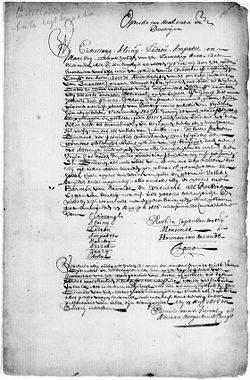Treaty of Butre (1656)
Text
[edit]
Dedication of Upper Anta and Boutry
We Cubiessang, Aloinij, Ladiou, Ampatee and Maniboij, chiefs of the Country Anta, proclaim for all and everyone that we have decided to place ourselves again under the old protection of the Dutch West India Company. This decision was taken in view of the good treatment for this country under the jurisdiction of the Honourable Company at Axem, and in view of the adverse circumstances of the war (with those of Encassar).
To which we have requested the Director General of the same, residing at the Castle St. George Delmina, who, at the instance of the request, came to Boutry, to accept possession of that which was offered him.
So is it that the indicated places have subjugated themselves to him, on the condition that he has to fortify and make the same defendable, in order to keep us safe and free from the dangers of war, as vassals of Most Honourable Gentlemen, the States General of the United Netherlands, as well as the Honourable Company (whose orders from this day we will submit to absolutely).
We bind our persons and possessions, as well as all our dependents and dependencies, in case we may ever be found to have done something against the good faith and contrary to the behaviour of good vassals.
All of which we, and with us Harman van Sacondee, Menemé, and Rochia, captain of Boutry, have ratified with our oath and signed with our own hand.
Done at Boutry on the 27th August 1656.
[signed]
Cubiessangh
Aloinij
Ladiou
Ampatee
Maniboij
Azizon
Guary
Acha
Rochia, captain of Boutry
Menemee
Harman van Saccondee
We, the undersigned, declare that this letter of dedication and vassalage was only drawn up at the express request of the inhabitants of the Upper Quarter of Anta, as well as translated for the chiefs who declared that everything was in agreement with their own opinion, which they confirmed by signing the same, which we also do with our signature, under presentation of an oath. Anno Domini 27 August 1656 at Boutry.
[signed]
Eduard Man, fiscal
Adriaan Hoogenhouck, commissioner
Source
[edit]- Nationaal Archief of the Netherlands, Old West India Company, cat. no. 12, Treaties and contracts 1640-1674.
References
[edit]- Doortmont, Michel R. & Jinna Smit, Sources for the mutual history of Ghana and the Netherlands. An annotated guide to the Dutch archives relating to Ghana and West Africa in the Nationaal Archief, 1593-1960s. Leiden: Brill 2007, 280-281.
- van Dantzig, Albert, Forts and castles of Ghana. Accra: Sedco Publishing 1981.
